

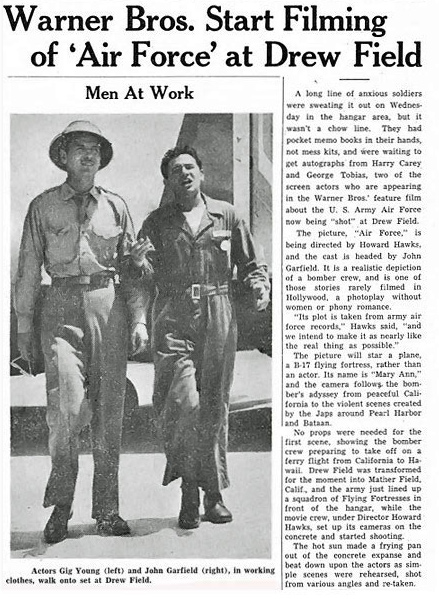 Friday, July 31, 1942 Friday, July 31, 1942A long line of anxious soldiers were sweating it out on Wednesday in the hangar area, but it wasn't a chow line. They had pocket memo books in their hands, not mess kits, and were waiting to get autographs from Harry Carey and George Tobias, two of the screen actors who are appearing in the Warner Bros.' feature film now being "shot" at Drew Field. The picture, "Air Force," is being directed by Howard Hawks and the cast is headed by John Garfield. It is a realistic depiction of a bomber crew and is one of those stories rarely filmed in Hollywood; a photoplay without women or phony romance. "The plot is taken from army air force records," Hawks said, "and we intend to make it as nearly like the real thing as possible." The picture will star a plane, a B-17 flying fortress, rather than an actor. It's name is "Mary Ann" and the camera follows the bomber's odyssey from peaceful California to the violent scenes created by the Japs around Pearl Harbor and Bataan.
|
|
No props were needed for the first scene,
showing the bomber crew preparing to take off on a ferry flight from
California to Hawaii. Drew Field was transformed for the moment into
Mather Field, California, and the army just lined up a squadron of Flying
Fortresses in front of the hangar, while the movie crew, under director
Howard Hawks, set up its cameras on the concrete and started shooting. The hot sun made a frying pan out of the concrete expanse and beat down upon the actors as simple scenes were rehearsed, shot from various angles and re-taken. John Garfield, cast as a gunner, idled around in a pair of coveralls awaiting his term; beefy George Tobias rolled down the tops of his dungarees and tried to cool off while lying under the wing of a bomber; and other actors wandered from shade to shade, talking about the humidity. The soldiers, looking on and lying in the shade of the bomber wings, felt sorry for "those movie guys." As the story progresses, Drew Field will become Hickam Field in Hawaii, Clark Field in the Philippines, and an air base in Australia. The movie will undertake to recreate thrilling scenes from the air battles of the Pacific. Included in the bomber crew are such screen notables as John Garfield, George Tobias, Harry Carey, Ward Wood, John Ridgely, Ray Montgomery, Charles Drake, Gig Young, Arthur Kennedy and Jim Brown. Maj. Sam Triffy, of the Washington Bureau, is the technical advisor for the Army. Brig. Gen. Carlyle H. Wash, commander of the Third Air Force, and Col. Melvin H. Asp, commander of Drew Field, are cooperating with Warner's in making facilities available.
|
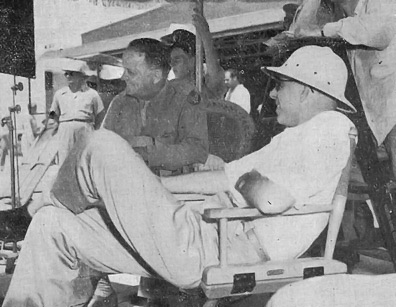 Aug. 7, 1942 - Vol. 1, Issue 23 In keeping with the policy of the War Department, Col. Melvin B. Asp, commanding officer of Drew Field, is giving director Howard Hawks and his party of actors, technicians and property men, every consideration possible during their stay at Drew Field where many thrilling scenes of Warner Bros new picture, "Air Force," is being made. Here the Base Commander is shown with Director Hawks viewing the filming of a scene in the picture. The effect must have been very satisfactory, judging from the facial expressions.
John Garfield, Warner Bros. star, now on location at Drew Field where scenes of "Air Force" are being filmed, will appear in the USO show, "All in Fun" to be presented at the Field, Tuesday evening, August 18th. Garfield will recite Gene Fowler's dramatic soliloquy, "The Javis Bay Goes Down," which he has delivered with success at previous camp gatherings. "All in Fun" is a 90-minute riot of fun and hilarity coming directly from the Rhumba Casino in Chicago, where it received rare reviews from the critics. It is now scheduled to play at camps and naval stations throughout the country as part of the USO-Camp Show's program of free entertainment for soldiers. A cast of top notch performers includes such well known entertainers as Bobby Pine, Mack Pearson, Bob Alda, Ruth Foster, Sid Gould, Ray Janis, Dolly Bell, Sunny Shorr and others.
|
|
Friday, Aug. 21, 1942 - Vol. 1, Issue 25 Tuesday night brought the first successful USO show to Drew Field. "All in Fun" was definitely a hit. And as though the show itself wasn't enough, John Garfield and George Tobias appeared as guests. An Act burlesquing the soldiers really brought down the house; only two other acts surpassed it in applause--the torch singer and the girl tap-dancer (naturally). The show was sponsored by Captain Delano of the Special Services office and introduced by Corporal O. Z. Whitehead. Playing in front of Theater No. 1, the show was witnessed by 4,000 men. Every available seat was taken and before the show started it was "Standing Room Only." The soldiers agreed to a man that vaudeville was here to stay. John Garfield's recitation of Gene Fowler's dramatic soliloquy "The Javis Bay Goes Down" moved the soldiers deeply. Highlight of his appearance was a story about his daughter, aged four. She recently queried Papa Garfield: "Are you a movie actor?" Papa G. naturally replied "Yes," whereupon she inquired, "Are you a famous movie actor?" Again, yes. "Then maybe you can get Errol Flynn's autograph for me." George Tobias in his best Brooklynese related miscellaneous anecdotes concerning his travels while making movies. When a soldier asked him to do a scene from "Seargeant York," he replied in exasperation, "How do you expect me to remember any lines from that movie when I don't even know my lines in "Air Force?" A soldier's review of the Tuesday USO show might read,"'All in Fun' was real fun." |
|
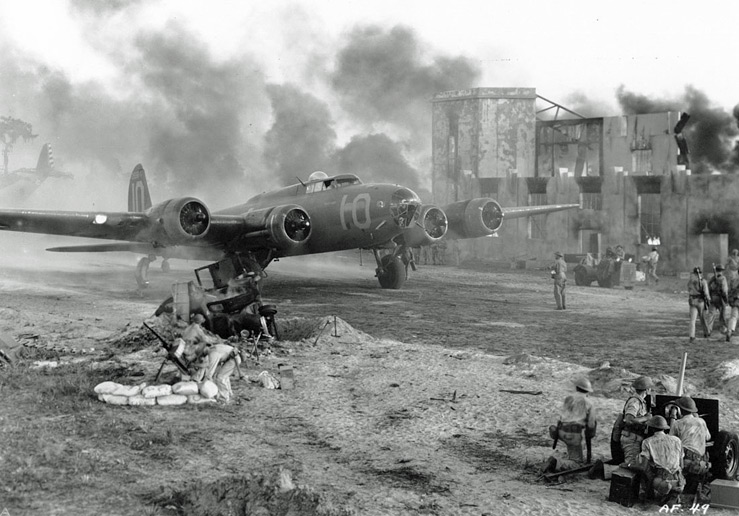
The Mary Ann as it arrives at
Hickam Field (Drew Field) after the attack on Pearl Harbor.
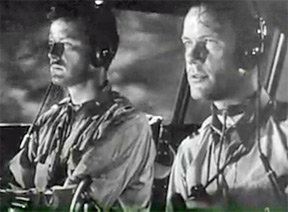
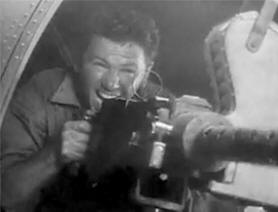
Release Date Production Dates The unarmed B-17 squadron arrives right at the beginning of the Japanese attack. This is based on a true incident; radar operators thought the Japanese planes they detected were an incoming flight of B-17s. The crew includes a disaffected gunner, Sergeant Winocki (John Garfield) who washed out of flight school after a mid-air collision in which another pilot was killed. Sergeant White, the Mary-Ann's crew chief (Harry Carey) is a long-time veteran in the Army Air Corps, whose son is a pilot. The pilots (John Ridgely) and (Gig Young) have to find a safe haven. Their routine ferry mission to Hawaii propels the Mary-Ann and its crew into the midst of war and their subsequent deployment to other Pacific bases include stops at Wake Island and the Philippines. Using wartime combat footage sparingly, the eventual missions in the Coral Sea mirror real-life events. The real Mary Ann was used on a tour to promote the film, then assigned to Hobbs Army Air Field in New Mexico. Some time in 1943 it was flown to Amarillo Army Air Field, where, according to a newspaper article, it was taken off flight status the next day, and assigned to ground school. One of the top three money makers for Warner Brothers in 1943. An uncredited William Faulkner wrote the emotional death bed scene for the Mary Ann's pilot. Actual newsreel footage was expertly inserted into the film, including scenes from the Battle of the Coral Sea. Henry Blair is in studio records/casting call lists playing "Quincannon's Son" and he's called Michael in the film, but he does not appear. Aerial scenes were filmed in Texas and Florida because airplanes appearing to be Japanese were not allowed on the west coast due to a fear of Japanese invasion. The U.S. Army Air Forces aircraft that appeared in the film were: - Ten Boeing B-17C/D Flying Fortresses from Hendrick Field, Sebring, Florida. - North American AT-6 Texans (as Japanese fighters) and Bell P-39 Airacobras, Curtiss P-40Cs and Republic P-43A Lancers from Drew Field. - Six Martin B-26C Marauders from McDill Field, Tampa, Florida, as the Japanese bombers. In the scene on Wake Island where a marine hands the dog to Assistant Crew Chief Weinberg (George Tobias), a voice can be heard telling the dog to give Weinberg a kiss. The voice was from the dog's owner and trainer, Frank Weatherwax. The dog, named Rommy, had appeared in numerous other movies including Reap the Wild Wind (1942), George Washington Slept Here (1942) and Without Love (1945). The aircraft that played the parts of Zeros in the film were actually Republic P-43A Lancers. The aircraft used to play "Mary Ann" was a B-17B, one of 19 that had the gunners' bubbles replaced by the flush gun positions of the B-17C and B-17D. This aircraft MAY have been aircraft 38-583 or possibly 39-010. Also, aircraft "18" in the movie is 38-269. Pause the scenes where John Ridgely has walked in front of the daytime flight line with numbers "18" and "05" in the back ground, and, as he is talking to the crew in the bombay, look through the gap between the bomb bay door and the fuselage: as you pause and forward frame-by-frame, you will see the tail of "18" just barely enough to see the numbers "8269" showing! This means that aircraft "18" is actually B-17B 38-269. The "Mary Ann" sadly was lost in the Pacific when it returned to combat duty after the release of the movie. The only members of "Maryann" killed during the film were both kissed good-bye at the beginning of the movie: John Ridgely ("The Pilot") by his wife and Ray Montgomery ("Assistant Radio Operator) by his mother. Also, these are the only crew members to have someone "see them off" at the beginning of their mission. |
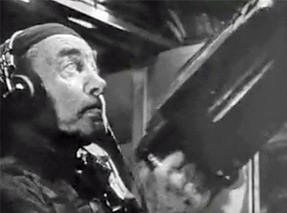
|
|
|
|
||
|
|
Watch a movie trailer for "Air
Force" |
|
Page1 | Page2 | Page3 | Page4 | Page5 | Page6 | Page7 | Page8 | Tampapix Home